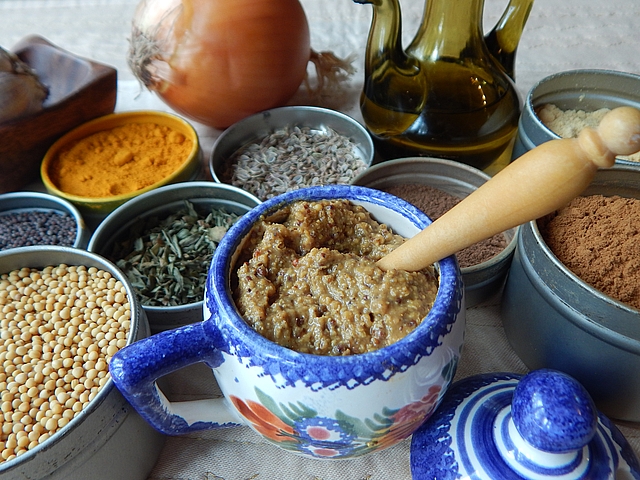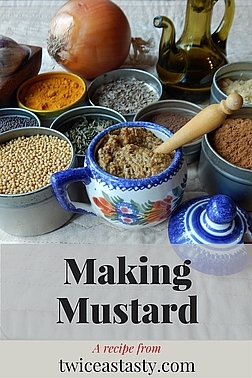Like most American kids, I grew up squeezing mustard from a bright yellow plastic bottle. Unlike most American kids, it was my favorite condiment from an early age, and as I grew older, I quickly shifted to my mom’s more sophisticated glass jar of Grey Poupon.
Although my stay-at-home mom made most of our meals from scratch, the only condiments she created were sweet jams and savory relishes. The idea that mustard could be made at home was only a vague notion inherited from my uncle, whose homemade Swedish-style spread was too heated for my young taste buds. The idea that mustard was easy to make didn’t sink in then. And yet if you have a kid who likes mustard, it’s a great parent–child project. My preferred version is a German style, with a grainy texture and a little less heat but packed with flavor.

Spicy German-Style Mustard
2 tablespoons brown mustard seeds
1/4 cup dry mustard
1/2 cup cold water
1 cup cider vinegar
1 small onion, chopped
1–2 tablespoons packed brown sugar
1 teaspoon salt
2 cloves garlic, minced
1/2 teaspoon ground cinnamon
1/4 teaspoon ground allspice
1/4 teaspoon dill seed
1/4 teaspoon tarragon
1/8 teaspoon turmeric
In a 2-cup measure, combine the mustard seeds, dry mustard, and water. Stir thoroughly to blend, and then let the seeds soak for at least 3 hours. In a 1- to 2-quart nonaluminum pan, combine the remaining ingredients. Simmer, uncovered, over medium heat for 10–15 minutes, until reduced by at least half; let cool to room temperature. Pour the vinegar mixture through a wire strainer into the mustard mixture. Puree with an immersion blender to the desired texture. Scrape into a clean, dry canning or other glass jar and let sit at room temperature for 1 day. Cover tightly and age for at least 3 days in the refrigerator before using. It keeps refrigerated for at least a year. Makes about 1-1/2 cups.
Tips & Tricks
- The combination of yellow and brown seeds and dry mustard gives this blend a different complexity than my uncle’s purely dry mustard spread (see below). Yellow seeds are milder than brown ones, so change the ratio to use more yellow seeds for a less pungent mustard.
- I prefer to stick with water in my mustard, but swapping in 1/4 to 1/2 cup of beer, wine, brandy, or apple cider for some of the water will give you an easy flavor variation. The sugar can be adjusted to taste; I like 2 tablespoons of brown sugar, but you can cut it back or swap in honey for a slightly different flavor.
- The salt and cider vinegar are not optional unless you plan to use the mustard in a few days; they preserve the spread and lock in its flavor. Cider vinegar also holds its own against the bite of the mustard seeds.
- The rest period before use removes the bitterness of newly made mustard, so plan ahead if you need a bit for Gorgeous Grilled Cheese, Salad Dressing, or Broccoli Cheese Soup.
- The first mustard recipe that I followed heated the mixture to thicken it at the end of the process, but I’ve since learned that temperature affects the bite given by the mustard seeds. Cold water gives the most bite; warmer water will mellow the mustard.
Twice as Tasty
 Uncle Sunny was an incredible person; my senior by almost 50 years, he was an amalgam of uncle and the grandfather who passed shortly before my birth. Whether we were visiting him and my aunt in their city townhouse or mountain cabin, I was always drawn to their kitchen. It seemed his territory, rather than a feminine domain. Pots and pans, jars of ingredients, and favored utensils were on full display on racks, open shelves, or hooks. My sister and I peeked in any closed cupboard or the refrigerator when we visited, hoping to see some exotic-looking jar or vegetable and never disappointed.
Uncle Sunny was an incredible person; my senior by almost 50 years, he was an amalgam of uncle and the grandfather who passed shortly before my birth. Whether we were visiting him and my aunt in their city townhouse or mountain cabin, I was always drawn to their kitchen. It seemed his territory, rather than a feminine domain. Pots and pans, jars of ingredients, and favored utensils were on full display on racks, open shelves, or hooks. My sister and I peeked in any closed cupboard or the refrigerator when we visited, hoping to see some exotic-looking jar or vegetable and never disappointed.
As kids, though, we had little interest in eating much of his stash, finding it too fiery, flavorful, or alcoholic. My favorite culinary memory of my uncle is predinner “cocktails” he made us in the snowed-in cabin’s kitchen before stepping out the door to garnish it with an icicle broken off the steel roof edge. Only after I was fully grown did I appreciate some of his best concoctions, including his hot yellow mustard. This is a halved version of his original recipe, with a few notes and explanatory directions of my own.
Hot Swedish-Style Mustard
1/4 cup firmly packed light brown sugar
1/4 cup honey
1/4 cup apple cider
1/4 cup vinegar
1/4 cup dry mustard
1-1/2 teaspoon unbleached flour
1/4 teaspoon ground cardamom
1/4 teaspoon ground cloves
Beat the eggs in a 1- to 2-quart nonaluminum pan. Add the remaining ingredients and mix well. Cook over low heat, stirring constantly, for about 10 minutes, until mixture thickens. Let cool. Transfer to a jar with a tight-fitting lid. Keeps refrigerated for at least 6 months. Makes about 1-1/2 cups.
Tips & Tricks
- This mustard always seemed hotter in my youth than it is; I almost equated it with a Chinese mustard, another of my uncle’s favorites. The sweetness of the honey and cider mellow it a bit, but there’s no denying that the straight dry mustard gives it plenty of bite.
- This mustard needs to be cooked slightly because of the eggs; in contrast, the long soak and then rest times of Spicy German-Style Mustard allow the mustard to set up uncooked.
- Also because of the eggs, let this mustard mellow in the fridge before you use it, rather than at room temperature.

I’ve been getting requests for how to create a homemade version of Grey Poupon. You definitely can use my Spicy German-Style Mustard recipe to make a Dijon mustard. The primary differences between my recipe and the classic Grey Poupon are that my recipe has a little more bite (from the dry mustard) and lacks wine. To alter the recipe, I would only use 1 tablespoon or leave out the dry mustard and replace the apple cider vinegar with 3/4 cup white wine vinegar and 1/4 cup white wine. The spices are likely different as well, so you can play with those if the first attempt isn’t quite the flavor you want. Puree the mustard thoroughly for the classic Grey Poupon texture, or leave it coarser for the country style. And if you make the variation, be sure to share how it turned out!
LikeLiked by 1 person
What a loving tribute to Uncle Sunny, my beloved brother! Be sure to send this post to Sue. Love, Mom
LikeLike